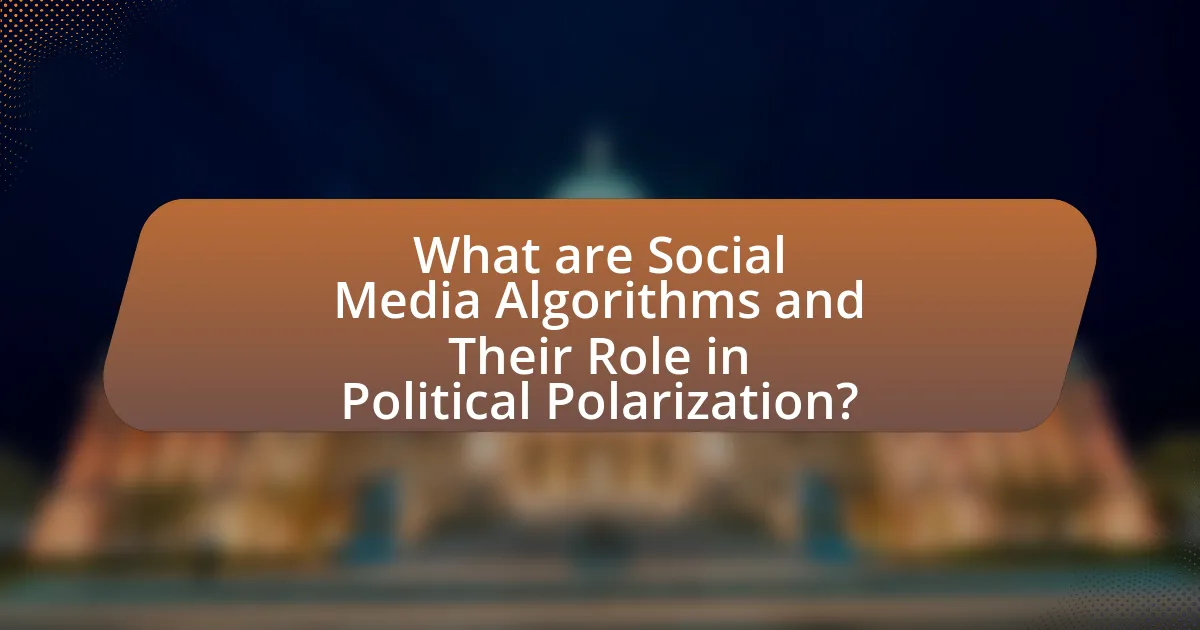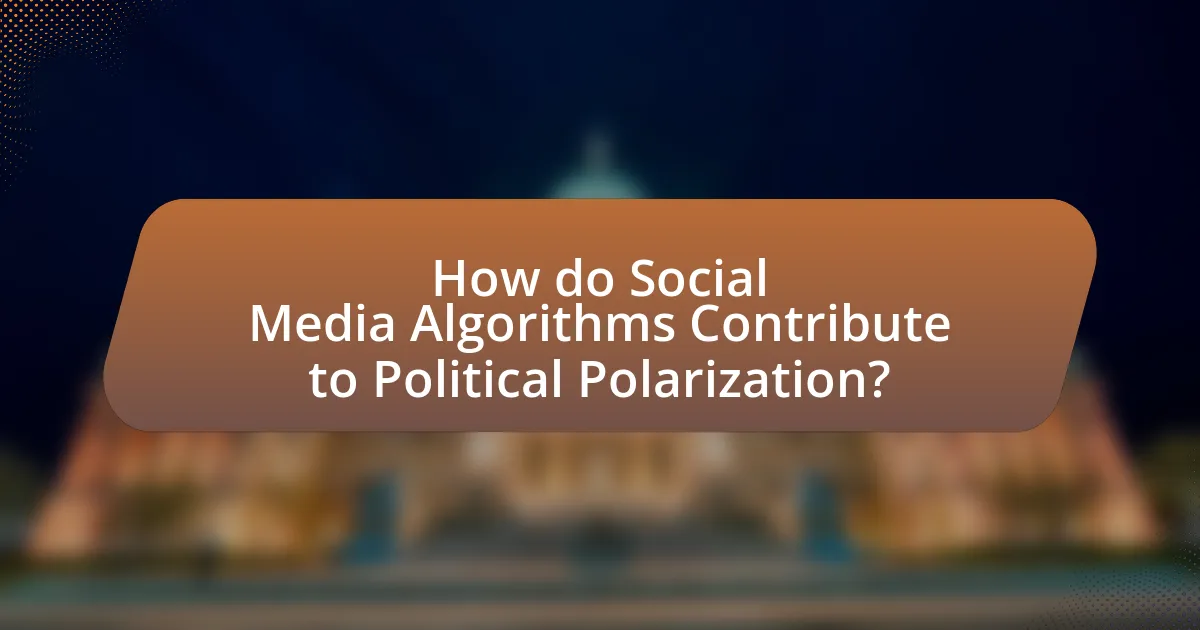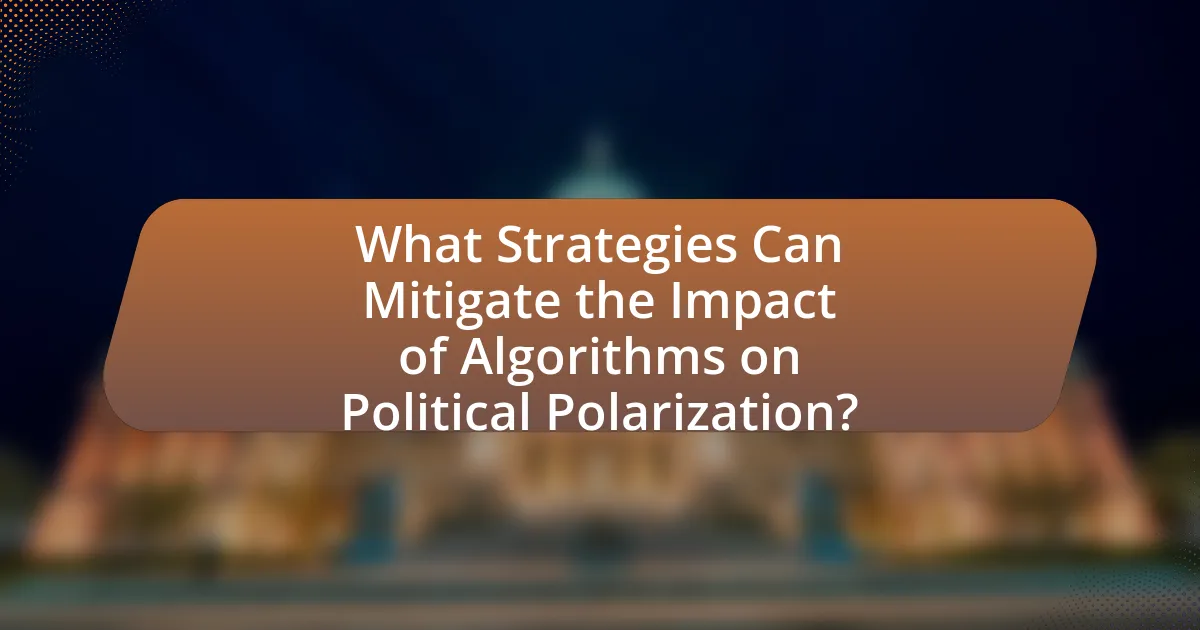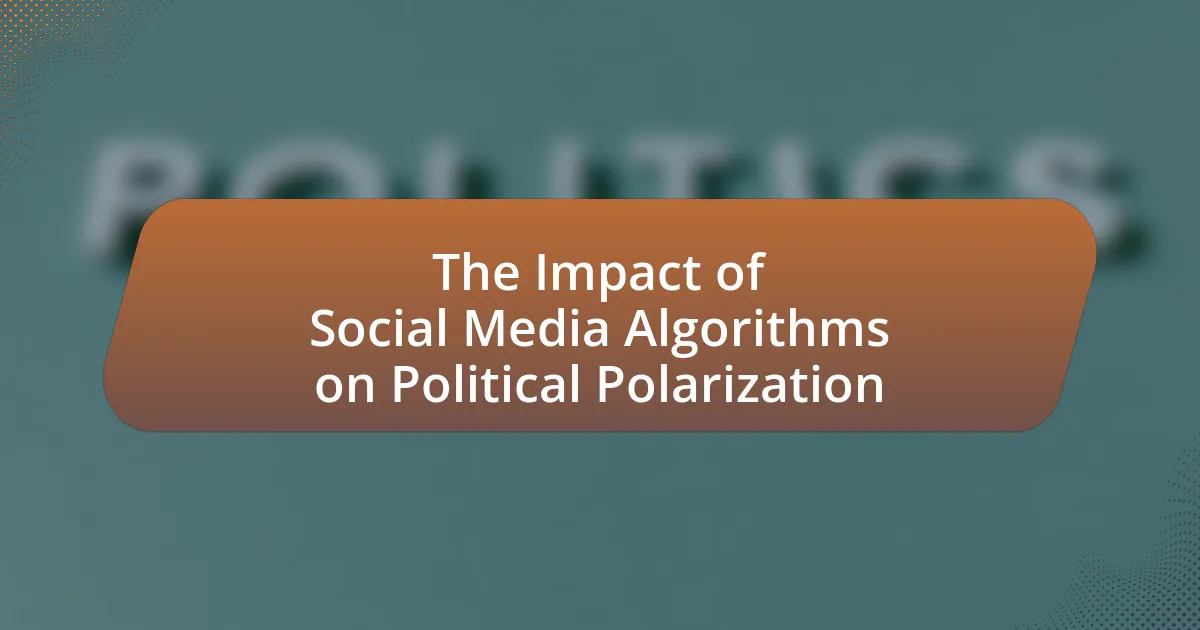Social media algorithms are automated systems that curate content based on user interactions, significantly influencing political polarization by creating echo chambers. These algorithms prioritize content that aligns with users’ existing beliefs, leading to selective exposure and a fragmented information environment. Research indicates that platforms like Facebook and Twitter amplify divisive content, exacerbating political divisions and undermining democratic processes. The article explores how these algorithms function, their impact on user behavior, and potential strategies to mitigate their effects on political discourse. Key components such as user engagement metrics, confirmation bias, and algorithmic transparency are examined to understand their role in shaping public opinion and fostering polarization.

What are Social Media Algorithms and Their Role in Political Polarization?
Social media algorithms are automated systems that determine the content users see based on their interactions, preferences, and behaviors. These algorithms play a significant role in political polarization by prioritizing content that aligns with users’ existing beliefs, thereby creating echo chambers. Research indicates that platforms like Facebook and Twitter utilize algorithms that amplify divisive content, leading to increased engagement and user retention. A study by Bakshy et al. (2015) found that Facebook’s algorithm can significantly influence the political views of users by exposing them predominantly to information that reinforces their pre-existing opinions. This selective exposure contributes to a fragmented information environment, exacerbating political polarization.
How do social media algorithms function?
Social media algorithms function by analyzing user data to determine which content is most relevant and engaging for each individual user. These algorithms utilize machine learning techniques to assess factors such as user interactions, preferences, and behaviors, thereby personalizing the content feed. For instance, platforms like Facebook and Instagram prioritize posts that generate higher engagement rates, such as likes, shares, and comments, which can lead to echo chambers and increased political polarization. Research indicates that algorithm-driven content curation can reinforce existing beliefs, as users are more likely to be exposed to information that aligns with their views, thus contributing to a fragmented information landscape.
What are the key components of social media algorithms?
The key components of social media algorithms include user engagement metrics, content relevance, and personalization factors. User engagement metrics, such as likes, shares, and comments, determine how content is prioritized based on its interaction levels. Content relevance assesses how well a post aligns with a user’s interests and past behavior, influencing its visibility. Personalization factors tailor the content feed to individual preferences, utilizing data from user profiles and interactions to enhance user experience. These components collectively shape the information users receive, impacting their exposure to diverse viewpoints and potentially contributing to political polarization.
How do algorithms determine content visibility?
Algorithms determine content visibility by analyzing user engagement metrics, content relevance, and user preferences. These algorithms prioritize content that is likely to generate interactions, such as likes, shares, and comments, based on historical data and user behavior patterns. For instance, platforms like Facebook and Instagram utilize machine learning techniques to assess which posts resonate most with individual users, thereby influencing what appears in their feeds. Research indicates that algorithms can create echo chambers by consistently showing users content that aligns with their existing beliefs, which can exacerbate political polarization. A study by Bakshy et al. (2015) in “Proceedings of the National Academy of Sciences” found that social media algorithms significantly affect the diversity of information users are exposed to, reinforcing the impact of these algorithms on content visibility and societal discourse.
Why is political polarization a concern in today’s society?
Political polarization is a concern in today’s society because it undermines democratic processes and social cohesion. When individuals align strictly with one political ideology, they become less willing to engage in constructive dialogue, leading to increased hostility and division. Research from the Pew Research Center indicates that political polarization has intensified over the past two decades, with a significant rise in partisan animosity. This division can result in legislative gridlock, as opposing parties struggle to find common ground, ultimately hindering effective governance. Furthermore, social media algorithms exacerbate this issue by creating echo chambers, where users are primarily exposed to viewpoints that reinforce their existing beliefs, further entrenching polarization.
What are the indicators of political polarization?
Indicators of political polarization include increased ideological distance between political parties, heightened partisan identity, and greater affective polarization, which refers to the emotional hostility between opposing political groups. Research shows that in the United States, the ideological gap between Democrats and Republicans has widened significantly over the past few decades, with a Pew Research Center study indicating that the share of Americans who view the opposing party unfavorably has doubled since the 1990s. Additionally, social media usage has been linked to these indicators, as algorithms often reinforce existing beliefs by curating content that aligns with users’ preferences, further entrenching divisions.
How does political polarization affect democratic processes?
Political polarization undermines democratic processes by creating divisions that hinder consensus-building and compromise. When citizens are deeply divided along ideological lines, it leads to increased partisanship, which can result in legislative gridlock, as seen in the U.S. Congress where bipartisan cooperation has significantly declined over the past two decades. This polarization also diminishes public trust in democratic institutions, as individuals may perceive them as biased or ineffective, further exacerbating disengagement from the political process. Research indicates that social media algorithms amplify these divisions by promoting echo chambers, where users are exposed primarily to viewpoints that reinforce their existing beliefs, thus intensifying polarization and its negative effects on democracy.

How do Social Media Algorithms Contribute to Political Polarization?
Social media algorithms contribute to political polarization by prioritizing content that aligns with users’ existing beliefs, thereby creating echo chambers. These algorithms analyze user behavior, such as likes and shares, to deliver more of the same type of content, which reinforces users’ viewpoints and discourages exposure to diverse perspectives. Research by the Pew Research Center indicates that 64% of Americans believe social media has a mostly negative effect on the way things are going in the country, highlighting concerns about the role of algorithms in shaping political discourse. Additionally, a study published in the journal “Nature” found that algorithm-driven content can lead to increased ideological segregation, as users are less likely to encounter opposing viewpoints.
What mechanisms do algorithms use to influence user behavior?
Algorithms influence user behavior primarily through personalization, recommendation systems, and engagement optimization. Personalization tailors content based on user data, such as past interactions and preferences, which increases the likelihood of user engagement. Recommendation systems suggest content that aligns with users’ interests, often leading to echo chambers where users are exposed primarily to viewpoints that reinforce their existing beliefs. Engagement optimization focuses on maximizing user interaction by prioritizing content that generates likes, shares, and comments, which can amplify extreme viewpoints and contribute to political polarization. Research by the Pew Research Center indicates that algorithm-driven content can lead to increased exposure to partisan information, further entrenching users in their political ideologies.
How does echo chamber effect arise from algorithmic filtering?
The echo chamber effect arises from algorithmic filtering by creating a feedback loop that amplifies users’ existing beliefs while minimizing exposure to opposing viewpoints. Social media platforms utilize algorithms that prioritize content based on user engagement, leading to the reinforcement of similar opinions and the exclusion of diverse perspectives. Research indicates that users are more likely to interact with content that aligns with their preferences, which algorithms then promote, further entrenching their views. A study by Bakshy et al. (2015) found that Facebook’s algorithm significantly limits the diversity of news articles users see, contributing to the polarization of political opinions.
What role does confirmation bias play in algorithm-driven content?
Confirmation bias significantly influences algorithm-driven content by reinforcing users’ pre-existing beliefs and preferences. Algorithms curate content that aligns with users’ past interactions, leading to a feedback loop where individuals are exposed primarily to information that confirms their views. Research indicates that this selective exposure can exacerbate political polarization, as users become entrenched in their ideologies and less open to opposing perspectives. A study by Bakshy et al. (2015) found that Facebook’s algorithm promotes content that aligns with users’ interests, which can limit exposure to diverse viewpoints and deepen ideological divides.
What evidence exists linking algorithms to increased polarization?
Evidence linking algorithms to increased polarization includes studies demonstrating that social media algorithms prioritize content that aligns with users’ existing beliefs, leading to echo chambers. For instance, a study by Bakshy et al. (2015) published in “Proceedings of the National Academy of Sciences” found that Facebook’s algorithm promotes content that reinforces users’ political views, resulting in reduced exposure to opposing perspectives. Additionally, research by the Pew Research Center indicates that algorithm-driven recommendation systems on platforms like YouTube can lead users down “rabbit holes” of extreme content, further entrenching their views. These findings collectively illustrate how algorithms contribute to political polarization by curating information that aligns with users’ preferences while minimizing exposure to diverse viewpoints.
What studies have been conducted on algorithm impact?
Studies on algorithm impact, particularly regarding social media and political polarization, include research by Bakshy et al. (2015) titled “Exposure to Ideologically Diverse News and Opinion on Facebook,” published in Science. This study found that Facebook’s algorithm tends to reinforce users’ existing beliefs by curating content that aligns with their political views, thereby contributing to polarization. Another significant study is “The Echo Chamber Effect on Social Media” by Cinelli et al. (2020), which analyzed how algorithms create echo chambers that limit exposure to diverse viewpoints, further entrenching political divisions. Additionally, the Pew Research Center’s report “The Role of Social Media in Political Polarization” (2020) highlights how algorithm-driven content delivery affects users’ political attitudes and behaviors, emphasizing the role of algorithms in shaping public discourse. These studies collectively demonstrate the substantial impact of algorithms on political polarization through selective exposure and reinforcement of existing beliefs.
How do user engagement metrics correlate with polarization trends?
User engagement metrics, such as likes, shares, and comments, correlate positively with polarization trends by amplifying extreme viewpoints. Research indicates that social media platforms prioritize content that generates high engagement, often leading to the promotion of divisive or sensationalist material. For instance, a study by Bakshy et al. (2015) in “Proceedings of the National Academy of Sciences” found that users are more likely to share politically charged content, which reinforces echo chambers and increases polarization. This dynamic suggests that as user engagement metrics rise, so too does the visibility of polarized content, creating a feedback loop that exacerbates societal divisions.

What Strategies Can Mitigate the Impact of Algorithms on Political Polarization?
Implementing algorithmic transparency and promoting diverse content exposure are effective strategies to mitigate the impact of algorithms on political polarization. Algorithmic transparency allows users to understand how content is curated, which can reduce misinformation and echo chambers. Research indicates that platforms like Facebook have begun to disclose more about their algorithms, which can help users critically evaluate the information they encounter. Additionally, promoting diverse content exposure through algorithm adjustments can encourage users to engage with a wider range of perspectives, thereby reducing polarization. Studies show that when users are exposed to opposing viewpoints, it can lead to more moderate political attitudes and increased understanding among different political groups.
How can users take control of their social media experience?
Users can take control of their social media experience by adjusting privacy settings, curating their feeds, and actively managing their interactions. By customizing privacy settings, users can limit who sees their content and what information is shared, thereby enhancing their control over personal data. Curating feeds involves following accounts that align with personal interests and unfollowing those that contribute to unwanted content, which can mitigate exposure to polarizing material. Actively managing interactions, such as blocking or reporting harmful content, empowers users to shape their online environment. Research indicates that users who engage in these practices experience a more positive social media experience and reduced exposure to divisive content, thus helping to counteract the effects of algorithms that may promote polarization.
What settings can users adjust to diversify their content feed?
Users can adjust settings such as content preferences, followed accounts, and notification settings to diversify their content feed. By selecting diverse interests in content preferences, users can receive a broader range of topics. Additionally, following accounts that represent various viewpoints and engaging with different types of content can further enhance diversity. Research indicates that algorithmic feeds often prioritize content similar to what users have previously engaged with, so actively modifying these settings can counteract echo chambers and promote exposure to varied perspectives.
How can users critically evaluate the information they consume?
Users can critically evaluate the information they consume by applying a systematic approach that includes verifying sources, checking for bias, and cross-referencing facts. Verifying sources involves assessing the credibility of the information provider, such as established news organizations or academic institutions, which often have rigorous editorial standards. Checking for bias requires users to identify any potential slant in the information, considering the author’s background and the publication’s reputation. Cross-referencing facts with multiple reliable sources helps ensure accuracy and provides a broader perspective on the topic. Research indicates that individuals who engage in these practices are less likely to fall victim to misinformation, as demonstrated in a study by Lewandowsky et al. (2012) published in “Psychological Science in the Public Interest,” which highlights the importance of critical thinking in media consumption.
What role do policymakers play in regulating social media algorithms?
Policymakers play a crucial role in regulating social media algorithms by establishing guidelines and frameworks that govern how these algorithms operate. They aim to ensure transparency, accountability, and fairness in algorithmic decision-making processes, which can significantly influence user behavior and public discourse. For instance, the European Union’s Digital Services Act mandates that platforms disclose their content moderation practices and algorithmic processes, thereby promoting greater accountability. Additionally, policymakers can implement regulations that address issues such as misinformation and hate speech, which are often exacerbated by algorithmic amplification. These regulatory efforts are essential in mitigating the effects of political polarization driven by biased or opaque algorithms.
What potential regulations could address algorithmic bias?
Potential regulations that could address algorithmic bias include mandatory algorithmic audits, transparency requirements for algorithmic decision-making processes, and the establishment of fairness standards. Mandatory audits would require companies to regularly assess their algorithms for bias, ensuring accountability and compliance with established fairness metrics. Transparency requirements would mandate that companies disclose how their algorithms function and the data they utilize, allowing for public scrutiny and informed oversight. Establishing fairness standards would provide a framework for evaluating algorithms against specific criteria, promoting equitable outcomes. These regulations are supported by findings from studies indicating that algorithmic bias can significantly impact social outcomes, necessitating structured oversight to mitigate risks associated with biased algorithms.
How can transparency in algorithms be improved?
Transparency in algorithms can be improved by implementing clear documentation and open-source practices. Clear documentation allows users to understand how algorithms function, including their decision-making processes and data usage. Open-source practices enable external scrutiny and collaboration, fostering trust and accountability. For instance, the Algorithm Transparency Standard developed by the Partnership on AI encourages organizations to disclose algorithmic processes, which can enhance public understanding and mitigate biases.
What best practices can social media platforms adopt to reduce polarization?
Social media platforms can reduce polarization by implementing algorithmic transparency and promoting diverse viewpoints. Algorithmic transparency allows users to understand how content is curated, which can mitigate echo chambers. Research indicates that platforms like Facebook have adjusted their algorithms to prioritize content from friends and family over news sources, which can lead to increased polarization. Additionally, promoting diverse viewpoints through features that highlight opposing perspectives can encourage constructive dialogue. A study by the Pew Research Center found that exposure to differing opinions can reduce polarization, suggesting that platforms should actively curate content that includes a range of political perspectives.
How can platforms promote diverse viewpoints effectively?
Platforms can promote diverse viewpoints effectively by implementing algorithms that prioritize content diversity and user exposure to differing opinions. Research indicates that algorithms designed to present a range of perspectives can reduce echo chambers and enhance users’ understanding of various viewpoints. For instance, a study by the Pew Research Center found that users exposed to diverse content are more likely to engage in constructive discussions and develop a broader understanding of complex issues. By adjusting algorithms to include a wider array of sources and viewpoints, platforms can foster a more inclusive dialogue and mitigate the effects of political polarization.
What initiatives can be implemented to foster constructive dialogue?
To foster constructive dialogue, initiatives such as promoting media literacy programs, implementing algorithm transparency, and encouraging diverse online interactions can be effective. Media literacy programs educate users on critically evaluating information, which can reduce the spread of misinformation and enhance understanding. Algorithm transparency allows users to see how content is curated, enabling them to recognize biases and seek out varied perspectives. Encouraging diverse online interactions, such as cross-partisan discussions and collaborative projects, can help bridge divides and promote empathy among differing viewpoints. These initiatives are supported by research indicating that exposure to diverse opinions can mitigate polarization and enhance dialogue quality.
